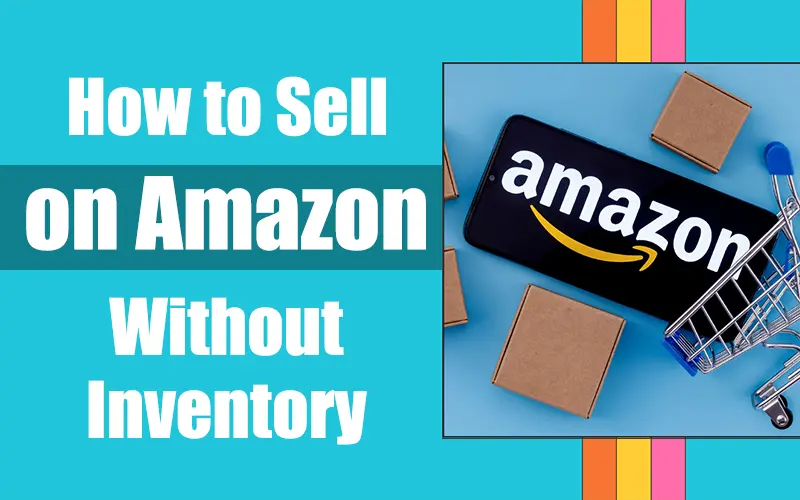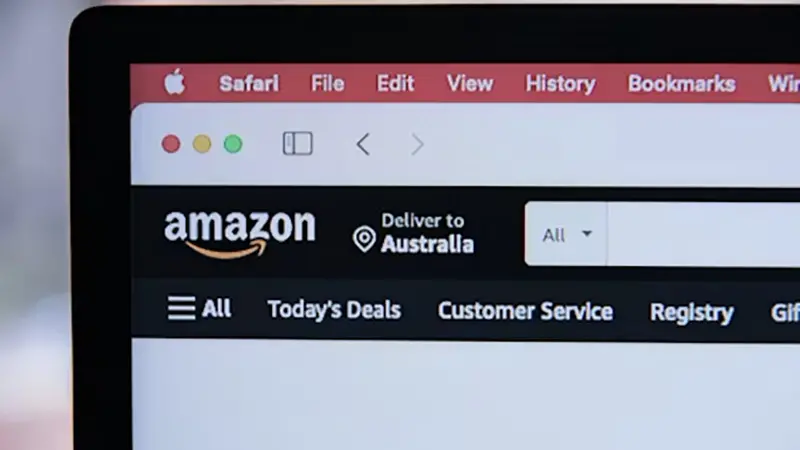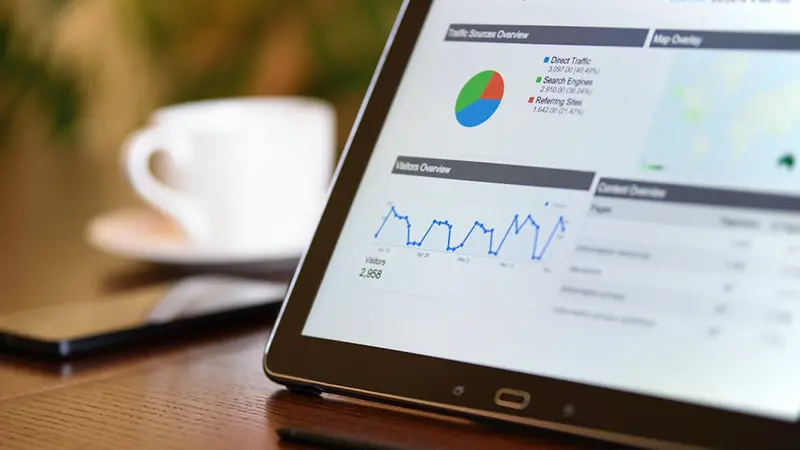In the ever-evolving landscape of e-commerce, finding innovative ways to make a profit without significant upfront investment has become a holy grail for entrepreneurs. Among these strategies, learning how to make money selling on Amazon without inventory stands out as a particularly appealing option. This approach not only reduces the financial barriers to entry but also simplifies the logistics of starting and running an online business.
Let’s explore five easy methods that e-sellers can utilize to tap into Amazon’s vast marketplace without the need to manage physical stock. From dropshipping to print-on-demand and beyond, we’ll delve into how each method works, its pros and cons, and practical tips to get started. Learn how to take advantage of Amazon’s vast platform without the hassle of managing traditional inventory with the help of this informative guide.

Selling on Amazon without Inventory
Selling on Amazon without inventory can be a lucrative business model. However, it requires careful supplier selection, strategic planning, and effective marketing to overcome the challenges and capitalize on the benefits of global reach and operational flexibility. Here are the unique set of opportunities and challenges associated with this business model:
Benefits
- Cost-effective: Learning how to sell on Amazon without buying products eliminates the need for significant upfront investment in inventory and storage, reducing overall startup costs.
- Flexibility and low risks: Offers the ability to quickly adapt to market changes without the burden of unsold inventory, minimizing financial risks.
- Global reach: Access to Amazon’s extensive international customer base, enabling sellers to expand their market presence far beyond local boundaries.
Challenges
- Heavily dependent on suppliers: Reliability on third-party suppliers for product quality, availability, and timely delivery can impact customer satisfaction and business reputation.
- Little control over product: Limited ability to customize or differentiate products, making it challenging to stand out in a competitive marketplace.
- Lower profit margins: Dependence on third-party suppliers and Amazon’s fees can result in thinner margins compared to traditional retail models with direct control over inventory and supply chain.
5 Methods for Selling without Inventory Management on Amazon
Ready to sell on Amazon without inventory? Let’s delve into five innovative methods that entrepreneurs can utilize to sell products on Amazon without the need to stock items themselves. Each method offers a distinct approach to leveraging Amazon’s platform to generate revenue while bypassing the traditional inventory management process.
We’ll explore the ins and outs of these strategies, highlighting how they work and considerations to keep in mind.
1. Dropshipping on Amazon
Dropshipping is one of the most popular methods of selling on Amazon. In this method, the seller never sees or handles the product, leveraging the efficiency of dropshipping to minimize inventory and storage costs. It offers an accessible entry point into e-commerce with reduced risks and investments.
However, diligent supplier management, strategic pricing, and a focus on customer service are required to navigate its challenges and cultivate a successful online business.

How Dropshipping on Amazon Works
- Listing Products: A seller lists products for sale on Amazon without having them in inventory.
- Customer Orders: When an order is placed, the seller buys the product from a third-party supplier at a lower price.
- Order Fulfillment: The supplier directly ships the product to the customer on the seller’s behalf.
- Profit Margin: The seller earns a profit based on the difference between the selling price on Amazon and the purchase price from the supplier.
Pros of Dropshipping on Amazon
- Ease of Scaling: With no inventory to manage, you can focus on marketing and selling products to scale your business instead of distracting by physical logistics.
- Operational Efficiency: Eliminates the need for a physical warehouse and the associated costs of handling and shipping, streamlining operations.
- Wide Product Selection: Allows for the listing of a diverse range of products, enabling sellers to quickly adapt to consumer trends and demands without financial risk.
Cons of Dropshipping on Amazon
- Quality Control Issues: Since the seller doesn’t handle the product directly, there’s a risk of suppliers sending out products that are damaged or not up to the expected quality standards.
- Shipping Complexities: Managing shipping for products from multiple suppliers can be complex. Longer shipping times are a common issue, affecting customer satisfaction.
- Branding Challenges: With products being shipped directly from the supplier, opportunities for personalized branding and packaging are limited, which can make it harder to build a strong brand identity on Amazon.
2. Amazon FBA
Amazon FBA (Fulfillment by Amazon) is a service designed to help sellers automate their shipping and handling process by leveraging Amazon’s extensive logistics network. It is a powerful tool for sellers and offers a way to enhance customer satisfaction and reach a broader audience.

How Amazon FBA Works
- Send Inventory to Amazon: Sellers ship their products directly to Amazon’s fulfillment centers, where they are stored until an order is placed.
- Order Processing: When a product is ordered by a customer, Amazon takes care of all aspects of order processing on behalf of the seller.
- Customer Service and Returns: Amazon provides 24/7 customer service and processes returns for products sold, easing the burden on sellers.
- Global Reach: With Amazon’s global network of fulfillment centers, sellers can easily sell their products to customers worldwide.
Pros of Amazon FBA
- Prime Eligibility: Products fulfilled by Amazon are eligible for Amazon Prime, which can significantly increase visibility and sales due to the appeal of free two-day shipping.
- Customer Trust: Leveraging Amazon’s brand for fulfillment can increase customer trust and satisfaction due to their reliable customer service and return policies.
- Simplified Logistics: Amazon’s handling of storage, shipping, and customer service simplifies logistics for sellers, allowing them to focus on product development and business growth.
Cons of Amazon FBA
- Costs: While FBA can save time and logistical headaches, it comes with fees for storage, fulfillment, and additional services, which can add up, especially for large or slow-moving inventory.
- Inventory Management: Sellers must keep a close eye on their inventory levels in Amazon’s fulfillment centers to avoid long-term storage fees and to ensure they have enough stock to meet demand.
- Less Control: Using FBA means less control over the packing process, which may impact branding efforts and the overall customer unboxing experience.
3. Amazon FBM
Amazon FBM (Fulfillment by Merchant) is a fulfillment option on Amazon where sellers are responsible for storing their inventory, packing, shipping their orders to customers, and managing customer service and returns. FBM gives sellers complete control over the handling and shipping processes.
This method is particularly attractive to sellers who prefer direct management of their products and customer interactions or those with the infrastructure to efficiently manage fulfillment at a lower cost than using FBA.
How Amazon FBM Works
- Storage and Inventory Management: Sellers store their own inventory, either in their own facilities or through a third-party logistics provider (3PL).
- Order Fulfillment: It is the seller’s responsibility to ship the product after picking it up and packing it appropriately.
- Customer Service: Sellers handle customer inquiries, returns, and exchanges, maintaining direct communication with their customers.
Pros of Amazon FBM
- Cost Control: Sellers can potentially lower their fulfillment costs if they have an efficient system for storage and shipping, avoiding Amazon’s FBA fees.
- Direct Customer Interaction: FBM allows sellers to have a direct relationship with their customers, offering opportunities for personalized customer service and brand building.
- Flexibility: Sellers have more flexibility in managing their inventory, packaging, and shipping methods, allowing for customized branding and packaging experiences.
Cons of Amazon FBM
- Increased Responsibility: The seller looks over all aspects of fulfillment, which can be time-consuming and require a significant logistical effort.
- No Prime Eligibility: FBM products are generally not eligible for Amazon Prime unless the seller qualifies for Seller Fulfilled Prime, which has strict requirements.
- Potential for Higher Shipping Costs: Without access to Amazon’s shipping rates, sellers might face higher shipping costs, especially for international shipments.
Incorporating 3PL into Amazon FBM
A Third-Party Logistics (3PL) provider is a third-party business used by sellers to outsource elements of their distribution, warehousing, and fulfillment services. Sellers using FBM can partner with a 3PL provider to handle the physical aspects of storage, packing, and shipping. This collaboration can offer several advantages:
- Scalability: 3PL providers can help FBM sellers scale their operations without the need for personal warehousing facilities, adapting to fluctuating demand with ease.
- Expertise and Efficiency: 3PLs bring expertise in logistics and can often offer more efficient and cost-effective shipping solutions than a seller could achieve independently.
- Geographic Flexibility: By using 3PL services with multiple fulfillment centers, sellers can store inventory closer to their customers, reducing shipping times and costs.
4. Print-on-Demand
Print-on-demand on Amazon offers a flexible and risk-averse path for selling customized products and self-publishing books. It suits creators and entrepreneurs looking to test product ideas or enter e-commerce without significant initial investment.
This method integrates seamlessly with Amazon’s platform, offering a unique way for creators and entrepreneurs to sell custom merchandise with minimal risk and overhead.

How Print-on-demand Works
- Product Design: Sellers design their products and upload these designs to a POD platform that integrates with Amazon, such as Amazon’s Kindle Direct Publishing (KDP) for books or a third-party service for other merchandise.
- Listing on Amazon: Products are listed for sale on Amazon. When a customer makes a purchase, the order is automatically forwarded to the POD service.
- Production and Fulfillment: The POD service prints or manufactures the product per the order and ships it to the customer.
- Profit: The seller earns a profit based on the difference between the sale price on Amazon and the cost of production and fulfillment charged by the POD service.
Pros of Print-on-Demand on Amazon
- Low Startup Costs: There’s no need to invest in inventory or storage space, making it an accessible option for new entrepreneurs and creators.
- Customization: POD allows for high degrees of product customization, catering to niche markets and individual customer preferences.
- Scalability: Sellers can easily add new designs or products without worrying about unsold inventory, allowing for rapid experimentation and adaptation to market trends.
Cons of Print-on-Demand on Amazon
- Lower Profit Margins: The cost of individual production and fulfillment can be higher than bulk manufacturing, resulting in lower profit margins per item sold.
- Limited Control Over Fulfillment: Dependence on POD services for manufacturing and shipping means sellers have less control over production times and quality.
- Competition: As the barrier to entry is low, the market can become quickly saturated with similar products, making differentiation and branding more challenging.
5. Selling Digital Products on Amazon
Selling Digital Products on Amazon is a lucrative avenue for entrepreneurs and creators to monetize their digital goods, such as ebooks, music, and digital art.
Amazon provides various platforms to facilitate the sale of digital products, including Kindle Direct Publishing for ebooks, Amazon Music for audio files, and the Amazon Appstore for software and mobile applications. This approach to e-commerce allows for selling products without the need for physical inventory, offering a high-margin opportunity with global reach.
How Selling Digital Products on Amazon Works
- Product Creation: Sellers create digital products, such as writing an ebook, developing software, or recording music.
- Platform Selection: Based on the type of digital product, the seller chooses the appropriate Amazon platform for listing and selling their product (e.g., Kindle Direct Publishing for ebooks).
- Listing and Publishing: The product is uploaded to the selected Amazon platform with detailed product descriptions, pricing, and any relevant metadata to enhance discoverability.
- Sales and Distribution: Customers can purchase and instantly download or access the digital product through Amazon’s platform. Amazon handles the transaction and digital delivery, crediting the seller’s account with the sale proceeds minus any applicable fees.
Pros of Selling Digital Products on Amazon
- High Profit Margins: Without the costs associated with physical production, storage, and shipping, digital products often have higher profit margins.
- Global Market Access: Sellers can reach a worldwide audience, providing their digital products to customers across different countries with ease.
- Passive Income Potential: Once a digital product is created and listed, it can continue to generate sales without additional effort, offering a source of passive income.
Cons of Selling Digital Products on Amazon
- Competition: The ease of entry for selling digital products means that markets can become quickly saturated, making it challenging to stand out.
- Marketing and Visibility: Success often depends on the seller’s ability to market their product effectively and optimize their listings for Amazon’s search algorithms.
- Platform Fees and Restrictions: Sellers are subject to Amazon’s platform fees, and there may be restrictions or guidelines specific to the type of digital product being sold.
How to Sell on Amazon Without Inventory
Starting an online business on Amazon without inventory allows you to leverage the platform’s vast customer base without the traditional costs associated with buying and storing goods. Here’s a step-by-step guide on how to sell on Amazon without buying products.
1. Set Up an Amazon Seller Account
- Choose Your Plan: Start by selecting between an Individual or Professional seller account on Amazon, depending on your anticipated sales volume and specific needs.
- Register: Provide your business details, including your legal business name, address, and tax identification information. You’ll also need a bank account where Amazon can send your sales proceeds.
- Account Verification: Amazon will verify your information for security and compliance reasons. This process can take some time, so be prepared to wait a few days.

2. Identify Profitable Products on Amazon
- Market Research: Use tools like Amazon’s Best Sellers list, Google Trends, and third-party tools like Jungle Scout or Helium 10 to identify in-demand products with high sales potential and manageable competition.
- Consider Niches: Focus on niche markets where you can offer unique value or meet specific customer needs, reducing direct competition with larger sellers.
- Evaluate Suppliers: If you’re considering dropshipping or print-on-demand, vet potential suppliers for reliability, product quality, and fulfillment speed.
3. Find A Dropshipping Supplier
- Find dropshipping suppliers: Find dropshipping suppliers through directories, online marketplace, networking, and recommendations.
- Vet Your Suppliers Carefully: Vet your supplier’s reputation, product quality, shipping time, and customer service to make sure they meet your requirements.
- Negotiate with Your Suppliers: Do previous research before you negotiate with the suppliers. Then, stay professional when you negotiate with your suppliers, and try to get multiple quotes and discounts.
4. Add Products and Optimize Listings
- Product Listings: Create detailed product listings on Amazon, including high-quality images, detailed descriptions, and relevant keywords to improve visibility and searchability.
- Optimization: Use Amazon SEO (Search Engine Optimization) principles to optimize your product lists and backend search terms to rank higher in Amazon search results.
- Pricing Strategy: Set competitive prices by analyzing your competition and considering your costs and desired profit margins.
5. Order Fulfillment
- Choose a Method: Decide whether you’ll fulfill orders yourself (FBM), use Amazon’s Fulfillment by Amazon (FBA) service, or work with a third-party logistics provider (3PL) for dropshipping or print-on-demand services.
- Streamline Operations: If handling fulfillment yourself, establish efficient processes for order processing, packaging, and shipping to ensure fast delivery times and minimize errors.
6. Customer Service and Return Management
- Develop Policies: Clearly outline your customer service policies, including returns, exchanges, and handling customer inquiries. Make these policies easily accessible to your customers.
- Be Proactive: Provide prompt and helpful customer service to address any issues or questions. This can help prevent negative reviews and build positive relationships with your customers.
- Handle Returns Gracefully: Manage returns and exchanges efficiently and courteously. A smooth return process can turn a potentially negative experience into a positive one, encouraging customer loyalty.
Additional Tips for Selling on Amazon
Here are some additional tips that can help you succeed in the competitive landscape of Amazon:
1. Choose Suppliers Carefully
The reliability and quality of your suppliers are paramount when you don’t manage inventory directly. A poor choice can lead to customer dissatisfaction, negative reviews, and ultimately, harm your business. One platform worth considering is EPROLO.
EPROLO is a dropshipping and e-commerce fulfillment platform designed to help online sellers find and source products. It offers an array of products and integrates directly with your Amazon store, automating the order fulfillment process.
2. Communicate with Your Suppliers and Set Clear Expectations
Maintain regular communication with your suppliers. Stay informed about any changes in inventory levels, product quality, or shipping times. Clearly communicate your expectations regarding product quality, packaging, and shipping times.
3. Market Your Products Effectively
Leverage Amazon’s pay-per-click (PPC) advertising to increase visibility for your listings and attract more potential buyers. If you want to advertise your products, you can make use of social media platforms to promote your offerings. If you have a customer email list, use it to inform your customers about new products, special offers, and other updates to encourage repeat business.

4. Provide Outstanding Customer Service
Address any issues customers may have with their orders in a timely and satisfactory manner. This can help prevent negative reviews and encourage positive ones. Finally, actively ask for customer feedback to understand how you can improve your products and service. Positive reviews on Amazon can significantly boost your product’s visibility and attractiveness to potential buyers.
Conclusion
Selling on Amazon without holding inventory presents a golden opportunity for entrepreneurs. Through models like dropshipping, Amazon FBA, Amazon FBM, print-on-demand, and digital products, sellers can tap into Amazon’s vast market reach while keeping operational costs low. However, success in this endeavor isn’t just about choosing the right model; it involves strategic planning, meticulous supplier selection, effective communication, robust marketing efforts, and unparalleled customer service.
Platforms like EPROLO have made it easier than ever to find reliable suppliers and automate the fulfillment process, but the onus remains on sellers to ensure customer satisfaction. Moreover, in the competitive landscape of Amazon, effective marketing and outstanding customer service are not just add-ons but essential components of a successful online business.
As we’ve navigated through the intricacies of selling on Amazon without inventory, it’s clear that while the challenges are real, the opportunities for growth, scalability, and profitability are immense.
FAQs
Can I sell on Amazon without having products?
Yes, you can sell on Amazon without keeping physical products. If you are wondering how to sell on Amazon without inventory, consider using methods like dropshipping, print-on-demand, or selling digital products. These models allow you to offer items or content without holding inventory.
Which method is fit for beginners?
Print-on-demand (POD) and dropshipping are considered the best methods for beginners looking to sell on Amazon without holding inventory. Both options require minimal upfront investment and reduce the risk associated with unsold stock.
POD allows for selling customized products with ease, while dropshipping eliminates the need for handling and storing physical products, making them ideal starting points for those new to e-commerce.
Can I use multiple selling methods simultaneously?
Yes, you can use multiple selling methods simultaneously on Amazon. Combining different methods, like dropshipping, print-on-demand, and selling digital products, can diversify your income streams and reduce business risk.
Can you buy stuff and then sell it on Amazon?
Yes, you can buy products and then sell them on Amazon. This is known as retail arbitrage, where you purchase products at a discount from retail stores or wholesalers and then sell them at a higher price on Amazon. It’s important to ensure that the products are not restricted and that you comply with Amazon’s selling policies.







